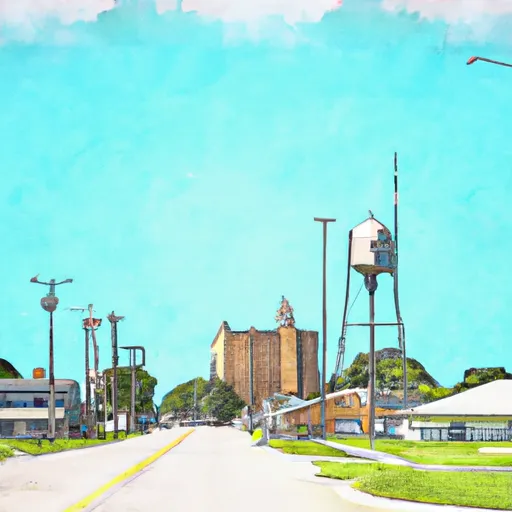-
 Snoflo Premium
Snoflo Premium
Get unlimited access to all our content
With no Ad interruptions! - Start Your Free Trial Login with existing account
Unadilla
Eden Index
Climate
8.1
•
Recreation
0.3
•
Community
•
Safeguard
3.3/10

Unadilla is a charming village located in Otoe County, Nebraska. The community enjoys a moderate continental climate with distinct seasons. Summers are warm and humid, with average temperatures in the mid-80s°F (around 29°C). Winters are cold and snowy, with temperatures ranging from the mid-20s°F to low 30s°F (around -4°C to -1°C). Spring and fall bring mild temperatures and colorful foliage.
The hydrology of Unadilla is primarily influenced by the nearby Salt Creek, a tributary of the Platte River. The area has fertile soil and is predominantly agricultural, with farming being a significant part of the local economy. The village is not directly situated on the banks of the creek but benefits from its presence.
Outdoor recreation opportunities in and around Unadilla are abundant. The area is dotted with picturesque parks and open spaces, providing an ideal setting for activities such as picnicking, hiking, and birdwatching. Fishing enthusiasts can cast their lines in nearby water bodies, including Salt Creek and various ponds. During the winter months, residents and visitors can enjoy ice skating and other winter sports. The tranquil rural surroundings of Unadilla make it a perfect destination for nature lovers and those seeking a peaceful outdoor experience.
What is the Eden Index?
The Snoflo Eden Index serves as a comprehensive rating system for regions, evaluating their desirability through a holistic assessment of climate health, outdoor recreation opportunities, and natural disaster risk, acknowledging the profound impact of these factors on livability and well-being.
Climate Health Indicator (CHI): 8.1
Unadilla receives approximately
786mm of rain per year,
with humidity levels near 82%
and air temperatures averaging around
11°C.
Unadilla has a plant hardyness factor of
5, meaning
plants and agriculture in this region thrive during a short period during spring and early summer. Most
plants will die off during the colder winter months.
By considering the ideal temperature range, reliable water supplies, clean air, and stable seasonal rain or snowpacks, the Climate Health Indicator (CHI) underscores the significance of a healthy climate as the foundation for quality living.
A healthy climate is paramount for ensuring a high quality of life and livability in a region, fostering both physical well-being and environmental harmony. This can be characterized by ideal temperatures, reliable access to water supplies, clean air, and consistent seasonal rain or snowpacks.
Weather Forecast
Streamflow Conditions
Missouri-Nishnabotna
Area Rivers
Missouri-Nishnabotna
Snowpack Depths
Missouri-Nishnabotna
Reservoir Storage Capacity
Missouri-Nishnabotna
Groundwater Levels
Recreational Opportunity Index (ROI): 0.3
The Recreational Opportunity Index (ROI) recognizes the value of outdoor recreational options, such as parks, hiking trails, camping sites, and fishing spots, while acknowledging that climate plays a pivotal role in ensuring the comfort and consistency of these experiences.
Access to outdoor recreational opportunities, encompassing activities such as parks, hiking, camping, and fishing, is crucial for overall well-being, and the climate plays a pivotal role in enabling and enhancing these experiences, ensuring that individuals can engage in nature-based activities comfortably and consistently.
Camping Areas
| Campground | Campsites | Reservations | Toilets | Showers | Elevation |
|---|---|---|---|---|---|
| Centralia Lake | None | 1,285 ft | |||
| Louisville Lakes State Rec Area | 300 | 1,032 ft | |||
| Weeping Water | 25 | 1,081 ft | |||
| Iron Horse Trail Lake | 11 | 1,132 ft | |||
| Eugene T. Mahoney State Park | 150 | 1,167 ft | |||
| Burchard Lake State Wildlife Area | 10 | 1,336 ft | |||
| St Marys Riverside Park | None | 944 ft | |||
| Walnut Creek - Papillion | 45 | 1,124 ft | |||
| Oregon Trail RV Park | 16 | 1,182 ft |
Nearby Ski Areas
Catastrophe Safeguard Index (CSI):
The Catastrophe Safeguard Index (CSI) recognizes that natural disaster risk, encompassing floods, fires, hurricanes, and tornadoes, can drastically affect safety and the overall appeal of an area.
The level of natural disaster risk in a region significantly affects safety and the overall livability, with climate change amplifying these risks by potentially increasing the frequency and intensity of events like floods, fires, hurricanes, and tornadoes, thereby posing substantial challenges to community resilience and well-being.
Community Resilience Indicator (CRI):
The Community Resilience Indicator (CRI) recognizes that education, healthcare, and socioeconomics are crucial to the well-being of a region. The CRI acknowledges the profound impact of these elements on residents' overall quality of life. By evaluating educational resources, healthcare accessibility, and economic inclusivity, the index captures the essential aspects that contribute to a thriving community, fostering resident satisfaction, equity, and social cohesion.

